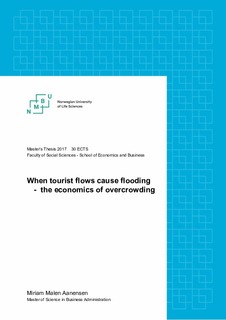| dc.contributor.advisor | Angelsen, Arild | |
| dc.contributor.author | Aanensen, Miriam Malen | |
| dc.date.accessioned | 2017-09-12T10:51:23Z | |
| dc.date.available | 2017-09-12T10:51:23Z | |
| dc.date.issued | 2017 | |
| dc.identifier.uri | http://hdl.handle.net/11250/2454243 | |
| dc.description.abstract | Today, people are travelling more than ever, and an increased amount of this travelling occurs in natural environments. There exists a fundamental relationship between the environment and tourism, as the environment is a fundamental ingredient for tourism development. However, the increased numbers of tourist at these places have the potential to destroy the very natural components that the travelling is based on in the first place. These increased numbers can lead to serious overcrowding and congestion issues at prime natural attraction, which again has negative effects on both the environment, the tourist experience and the host community.
The aim of this study is to contribute to a better understanding of the adverse effects stemming from increased tourism, and how the public good and open access nature of these natural resource cause problems of overexploitation and degradation of the environment. Through concepts of negative externalities and carrying capacity, the thesis will discuss the negative impacts occur and try to identify a threshold limit for when they occur. Furthermore, the study attempts to analyze different policy instruments than can be used to regulate tourism. Exclusion mechanisms such as tourist quotas, taxes and charges are analyzed according to neoclassical economic theory, to understand the effects the instruments has on quantity and price. Moreover, these instruments were assessed through criteria of effectiveness, equity and distribution and transactions costs to highlight the different aspects of the respective instruments and to understand the trade-off between them. | nb_NO |
| dc.description.abstract | I dag reiser folk mer enn noen gang før, og de siste tiår har vi sett en økende tendens til at folk velger naturopplevelser som sitt reisemål. Det eksisterer et fundamentalt forhold mellom natur og turisme, ettersom naturen selv er en del av turisme opplevelsen. Det økende antallet turister ved naturlige steder har et potensiale til å ødelegge selve naturen som turisme er grunnet i. Denne økende turismen kan føre til alvorlige problemer ved å overbefolke turiststeder, som blant annet fører til opphopning/kødannelser. Dette har negative effekter både på naturen, turistenes egen opplevelse og forvetninger, samt på vertssamfunnet.
Målet med denne oppgaven er å bidra til en bedre forståelse av de virkninger og bivirkninger som følger av økt turisme, og hvordan offentlige goder og den frie tilgangen til disse naturressursene forårsaker problemer med tanke på overutnyttelse og nedbrytning av miljøet. Gjennom begreper som eksternaliteter og miljøets bæreevne, diskuterer oppgaven de negative effektene som oppstår, og forsøker å diskutere en grensenivå for når de tiltrer. Videre forsøker studien å analysere ulike politiske virkemidler som kan brukes til å regulere turismen. Utelukkingsmekanismer som turistkvoter, skatter og avgifter, analyseres i henhold til neoklassisk økonomisk teori, for å forstå virkningene instrumentene har på mengde og pris. Videre blir disse instrumentene vurdert ved hjelp av kriterier for effektivitet, rettferdighet og distribusjon og transaksjonskostnader, for å markere de ulike aspektene ved de respektive instrumentene, samt å forstå avviket mellom dem. | nb_NO |
| dc.language.iso | eng | nb_NO |
| dc.publisher | Norwegian University of Life Sciences, Ås | nb_NO |
| dc.rights | Attribution-NonCommercial-NoDerivatives 4.0 Internasjonal | * |
| dc.rights.uri | http://creativecommons.org/licenses/by-nc-nd/4.0/deed.no | * |
| dc.subject | Tourism | nb_NO |
| dc.subject | Overcrowding | nb_NO |
| dc.subject | Tourism Economics | nb_NO |
| dc.subject | Policy Instruments | nb_NO |
| dc.title | When tourist flows cause flooding : the economics of overcrowding | nb_NO |
| dc.type | Master thesis | nb_NO |
| dc.subject.nsi | VDP::Samfunnsvitenskap: 200 | nb_NO |
| dc.source.pagenumber | 75 | nb_NO |
| dc.description.localcode | M-ØA | nb_NO |

